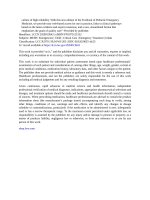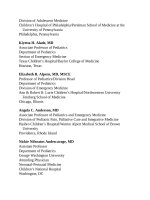Pediatric emergency medicine trisk 2722 2722
Bạn đang xem bản rút gọn của tài liệu. Xem và tải ngay bản đầy đủ của tài liệu tại đây (99.39 KB, 1 trang )
zoster infection can rapidly progress to a life-threatening infection in an
immunocompromised patient.
Typhlitis, also known as neutropenic colitis, is a potentially life-threatening
infection that occurs in patients with neutropenia and GI mucosal injury. This
infection occurs in the watershed regions of the cecum, appendix, and terminal
ileum. It is much more common in patients with advanced hematologic
malignancies but can occur in patients with solid tumors. Clostridium difficile colitis
is relatively common in oncology patients due to treatment with broad-spectrum
antibiotics that eradicates normal bowel flora.
Clinical Considerations
Clinical Recognition
In addition to sepsis, bacteremia, and soft tissue infections, the emergency clinician
should consider additional infectious complications not commonly encountered in
noncancer patients. Initial symptoms of typhlitis can mimic appendicitis with
periumbilical pain preceding right lower quadrant pain. As the infection progresses,
abdominal pain can become severe and examination findings include distention and
persistent right lower quadrant tenderness. C. difficile colitis should be considered in
patients with abdominal pain and diarrhea with or without abdominal distention.
Abdominal tenderness is generally minimal except in patients with very severe
colitis. Perirectal pain may be the presenting symptom of perirectal
abscess/cellulitis. Complaints of painful vesicular rash should raise concern for
varicella infection.
Clinical Assessment
Certain elements of the history can be very helpful. Patients, family members, or
referring oncologists may know if the patient is already neutropenic. Specific
questions to elicit any focal pain can direct the physical examination and empiric
treatment decisions since this may be the only evidence of a localizing infection.
The presence of any indwelling devices such as a central line, ventriculoperitoneal
shunt, or metal hardware used for bone tumors can also guide the differential
diagnosis and/or empiric antibiotic coverage. Since antibiotic allergies are common
in this population, a thorough allergy history is critical.
The physical examination of the patient must be detailed and meticulous with
careful attention paid to all mucocutaneous surfaces to elicit any focal tenderness,
erythema, or edema, which may be slight. Sites to examine include any central
venous access devices at the skin entrance site, subcutaneous reservoirs, and along
the subcutaneous line tract. Nail beds on both fingers and toes should be carefully
examined, and a thorough external rectal examination performed using









